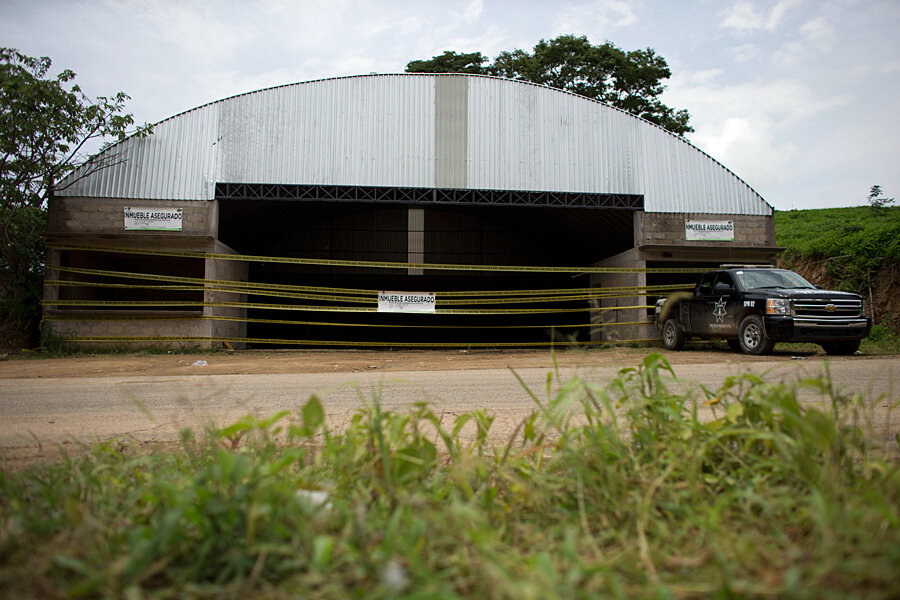Mexico shootout or massacre? Witness accounts challenge military's take.
Loading...
A dramatic shootout in the mountains of southern Mexico that left 22 people dead this summer led the government to paint the military as heroes, protecting citizens from the criminal gangs that have spread across parts of the country.
But the government’s account of being drawn into a shootout that left all suspected gang members dead, but only injured one soldier, raised eyebrows. And this week, Esquire Mexico and the Associated Press published stories with witness accounts from the June 30 shootout, casting the government’s account of the event into greater doubt and deepening mistrust.
The question of police and military accountability resonates globally – from the United States in the aftermath of the Michael Brown shooting in Ferguson, Mo., to nations in conflict, like Somalia, where peacekeepers were recently accused of coercing sexual favors from displaced people in exchange for humanitarian aid.
In Mexico, where former President Felipe Calderòn deployed more than 50,000 troops to stave off drug cartels and criminal gangs between 2006 and 2012, and where tens of thousands of Mexicans were killed or went missing in the same time period, there was hope that the new administration’s approach to drug violence could lead to greater respect for human rights.
After President Enrique Peña Nieto took office in 2012, he promised a more comprehensive approach to battling crime and violence in Mexico. But he hasn’t taken the military off the streets.
As The Christian Science Monitor reports:
"[Soldiers] are trained for confrontation, to defeat an enemy with force," says Alejandro Hope, a top Mexican security analyst….
Relying on military might to confront crime is leading to even more violence and widespread abuse, such as torture, disappearances, and a disproportionate use of force, critics say. Mexico's National Commission of Human Rights received more than 7,350 complaints of military abuses between 2007 and 2012, for example.
In the case of the summer shootout, Mexico’s Defense Department described a military patrol that came under fire from a warehouse where 21 armed men and one woman were taking cover. Esquire reports that the suspects allegedly had three women held hostage – who were freed by the military – and a battery of weapons. The shootout left every single person in the warehouse dead, and injured one soldier.
The AP’s witness said she went to the warehouse earlier in the night to convince her daughter – who had recently joined the gang – to return home. She was one of the women freed by the military and did not give her name. She said it was the military who shot first, and that only one in the group of gang members taking cover in the warehouse was initially killed.
The rest surrendered and abandoned their weapons on the promise that they would not be harmed, reports the AP. The soldiers spent hours interrogating the individuals, both outlets report, and then they allegedly executed each one of the suspected gang members.
Physical evidence at the scene – including a limited number of bullet holes on the outside of the warehouse where the gang members were hiding – pointed to more selective shootings, but the government maintains its version of events, the AP reports.
The Attorney General for the State of Mexico issued a statement in mid-July saying, "There were no shots at close range, the exchange of fire was proportional, and according to the trajectory of the bullets and the position in which the bodies were found, [there is] no indication of a possible execution."
The lopsided numbers weren’t a first for military shootouts in Mexico, and the AP reported at the time of the event that it raised concern among human rights groups who believed it was part of a larger pattern.
"It raises suspicion, the simple fact that there were 22 dead on one side and one wounded on the other side," Alejandro Hope, a Mexico-based security analyst, told the AP.
The AP requested autopsy results from the night of the shootout under Mexico’s freedom of information law, but were denied access. Human rights groups, including the Mexican Commission for the Defense and Promotion of Human Rights, have called on authorities to carry out a transparent investigation into the events, reports Mexico’s Proceso.
"If the testimony is true, we are facing one of the most serious massacres in Mexico," said Jose Miguel Vivanco, director of Human Rights Watch for the Americas.
"It's extremely important that we keep pressure on the officials so that hopefully soon they produce the records that should be scrutinized by the public in Mexico."








